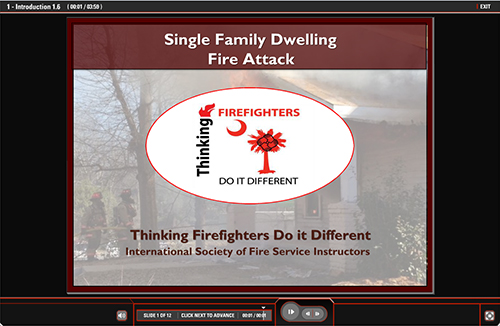ISFSI Single Family Dwelling Fire Attack
The International Society of Fire Service Instructors (ISFSI) in conjunction with the South Carolina Fire Academy and National Institute of Standards and Technology (NIST) have released an on-line training program addressing firefighting operations in single family dwellings.

This training program is comprised of five modules examining current research on fire dynamics and firefighting tactics and its application to operations in single family dwellings.
- Module 1: Introduction
- Module 2: Current Conditions
- Module 3: Ventilation
- Module 4: Suppression
- Module 5: Size-Up and Decision Making
ISFSI did an effective job of integrating their own research conducted in South Carolina along with current research from NIST, FDNY, and UL in developing and for the most part have provided an effective learning experience that is well worth the four hours needed to complete the training. Visit the ISFSI learning management system (LMS) at http://learn.isfsi.org/ to complete this course (and ISFIS’s building construction course as well).
Important lessons emphasized in Single Family Dwelling Fire Attack include:
- The fire environment has changed, resulting in faster fire development and transition to ventilation controlled conditions.
- Under ventilation controlled conditions, increased ventilation will result in increased heat release rate and temperature.
- In the modern fire environment, ventilation and fire attack must be closely coordinated. Particularly if resources are limited fire attack should often precede ventilation to minimize the adverse impact of ventilation without concurrent fire attack.
- Exterior attack can speed application of water into the fire compartment and frequently will have a positive impact on conditions.
- Speedy exterior attack can be an effective element of offensive operations.
- Smoke is fuel and presents a significant hazard, particularly at elevated temperatures. Hot smoke overhead should be cooled to minimize potential for ignition.
- Ongoing size-up needs to consider current and projected fire behavior as well as structural conditions.
While a solid training program, Single Family Dwelling Fire Attack could do a better job of explaining the differences between direct and indirect fire attack and how gas cooling impacts the fire environment to reduce the flammability and thermal hazards by the hot upper layer. The following posts expand on the challenges presented by shielded fires and application of gas cooling:
- Shielded Fires
- Shielded Fires Part 2
- Gas Cooling
- Gas Cooling Part 2
- Gas Cooling Part 3
- Gas Cooling Part 4
- Gas Cooling Part 5
Single Family Dwelling Fire Attack does a solid job of addressing size-up and decision making, but firefighters and fire officers need to develop a more in-depth understanding of reading the fire. The following posts provide an expanded look at this important topic:
- How to Improve Your Skills
- Building Factors
- Building Factors Part 2
- Building Factors Part 3
- Smoke Indicators
- Smoke Indicators Part 2
- Air Track Indicators
- Air Track Indicators Part 2
- Heat Indicators
- Heat Indicators Part 2
- Heat Indicators Part 3
- Flame Indicators
- Flame Indicators Part 2
- Putting it All Together
One great feature in Modules 3, 5 and 5 of Single Family Dwelling Fire Attack are brief video presentations by Dan Madrzykowski on Ventilation, Suppression, Size-Up and Decision Making which are also available on YouTube. The video on Ventilation is embedded below as a preview:
Tags: Anti-Ventilation, burning regime, fire behavior, fire behavior indicators, Fire Behavior Training, Fire Control, practical fire dynamics, reading the fire, Tactical Ventilation, vent controlled fire


